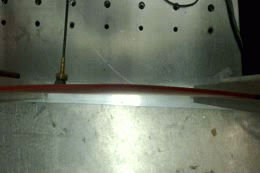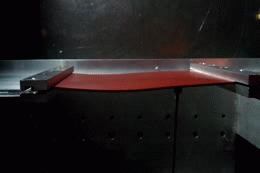The aeroelastic stability of rectangular plates are well-documented in literature for certain sets of boundary conditions. Specifically, wing flutter, panel flutter, and divergence of a plate that is clamped on all sides are well-understood. However, the ongoing push for lighter structures and novel designs have led to a need to understand the aeroelastic behavior of elastic plates for other boundary conditions.
Below is the link to one of our recent flutter/LCO experiments. In the video you will see a cropped delta wing (that simply means we cropped off that would otherwise be a delta or triangular wing). The wind speed in the wind tunnel is shown by the dial in one of the frames. In the other two frames you see signals from two strain gauges, bending and torsion, and of course the wind itself.
The wind speed at which flutter is predicted to occur theoretically is about 19 meters/second. The experimental flutter speed based on observation of the strain gauge signals is about 21 meters/second. Note that at the wind speed when flutter starts both strain gauges show dominant response at a frequency of 12 Hz. This large peak at a single frequency is a characteristic identifier of flutter. Also note that the motion of the wing is not easily visible to the eye until a higher wind speed in the range of 24-26 meters/second and the motion is most visible at the wing tip. Once the flutter speed is exceeded limit cycle oscillations occur due a strong structural nonlinearity.
Another example of a plate flutter problem is NASA's continuous mold-line link project for reducing the noise generated by commercial transport aircraft during landing; in order to reduce the noise generated by vortex shedding from the trailing edge flap during landing, the project proposes to connect the gap between the trailing edge flap and the rest of the wing with a flexible plate. A modular experimental test bed is shown below. The well-understood boundary conditions are used as test cases to validate the analysis results, and then results of additional configurations that have not been extensively explored are explored.
Aeroelastic Experiments
Image

| Image

| Image

|